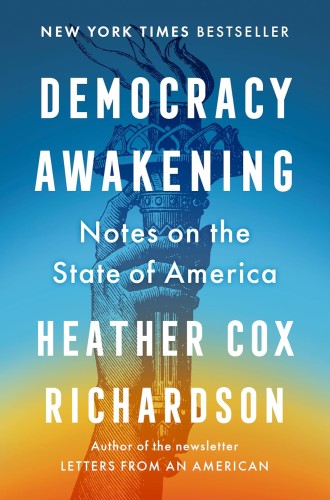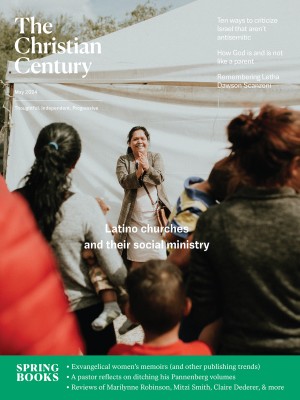Connecting the dots
Heather Cox Richardson guides us through serial attempts to overturn the liberal consensus in America.

Democracy Awakening
Notes on the State of America
As the United States—together with much of the world—teeters on the precipice of authoritarianism, a bit of historical context can’t hurt. Democracy Awakening provides some context leavened with a dash of hope that we can still, somehow, reverse course.
Heather Cox Richardson, a historian at Boston College and author of the popular Letters from an American newsletter, guides us through serial attempts to overturn the liberal consensus—a general acceptance of New Deal programs and modest business regulation—from the 1930s to the present. The Supreme Court’s Brown decision in 1954, she contends, “tied the active federal government not just to economic equality for white Americans but also to civil rights.” Opponents screamed “socialism” and adopted the mythological American cowboy as their totem; by 1959, the television schedule was populated by 26 westerns, including Bonanza, “a male world of hardworking cowboys protecting their land from evildoers.”
Read our latest issue or browse back issues.
Those laboring to roll back the liberal consensus also sought ideological ballast. William F. Buckley Jr., a defender of Joseph McCarthy, asserted that American universities peddled “secularism and collectivism,” ideas inimical to free enterprise and religion. Southern opposition to the Civil Rights Act of 1964 and the Voting Rights Act of 1965 fed into the “southern strategy,” which helped elect Richard Nixon in 1968. “The administration’s strategy of polarizing the country to pick up voters,” Richardson writes, “began to shatter the liberal consensus.”
The Republican formula of race-baiting and decrying socialism worked remarkably well. Ronald Reagan’s decision to open his general election campaign at Mississippi’s Neshoba County Fair on August 3, 1980, proclaiming his support for “states’ rights” in the place where the Ku Klux Klan, in collusion with the local sheriff’s office, murdered three civil rights workers 16 years earlier, provides the most blatant example. (Richardson fails to mention, however, that Reagan’s 1980 campaign photo depicted him wearing a cowboy hat.) Aside from his tax cuts that favored the wealthy, Reagan gutted the Civil Rights Commission and persisted in his support for the apartheid regime in South Africa. His elimination of the fairness doctrine in 1987 opened the door to media demagogues like Rush Limbaugh, Alex Jones, and a legion of imitators.
All the while, from Reagan to Donald Trump, conservatives stocked the judiciary with opponents of the liberal consensus while Republican-dominated legislatures steadily whittled away at voting rights and churned out gerrymandered districts. “Since the 1980s, political figures eager to get rid of that liberal consensus have gained power by denigrating it,” Richardson writes, even though that consensus produced unrivaled prosperity. The individualistic cowboy mythology took its toll, undermining equality and our sense of community in favor of a society ordered by racial or religious hierarchies. As Jimmy Carter warned in his farewell address, “the national interest is not always the sum of all our single or special interests.”
“And so, in 2016,” Richardson writes, “the Republicans would ride the themes of the past forty years to their logical conclusion,” later adding that “Trump married Republican politics to authoritarianism.”
Richardson is skilled at connecting dots. She links the Unite the Right rally in Charlottesville, Virginia, six months into Trump’s presidency, for instance, with the anti-Catholic mobs of the 1830s, the Klan rallies of the 1860s, and anti–New Deal demonstrations of the 1930s. More recent protests shifted toward violence against the government: Ruby Ridge, Idaho, which lured Aryan Nations members to defend Randy Weaver; the right-wing sympathy for David Koresh in Waco, Texas; Timothy McVeigh’s horrific revenge in Oklahoma City two years later; the Oath Keepers’ support for Cliven and Ammon Bundy.
Richardson’s narrative is compelling, if perhaps a bit too tidy at times. She claims that the turning point toward authoritarianism was Trump’s staged photo op, Bible in hand, in front of St. John’s Episcopal Church on Lafayette Square on June 1, 2020. There, in response to the Black Lives Matter movement and protests over the death of George Floyd, Trump (who had earlier threatened “when the looting starts, the shooting starts”) promised that “the greatest country in the world” was “coming back strong, it will be greater than ever before.” That was an important moment, to be sure, but Trump had already been moving steadily in that direction by appointing unqualified sycophants to positions of influence and by issuing a stream of false or misleading statements (30,573 in four years, according to the Washington Post) that culminated in the Big Lie of a fraudulent 2020 election. “If leaders repeat it enough times,” Richardson writes, “refusing to admit that it is a lie, people come to think it is the truth because surely no one would make up anything so outrageous.”
There are villains aplenty in this narrative. Richardson, ever confident in the durability of America’s democratic institutions, points a finger at the cowardice of most Republican senators, who failed twice to convict on impeachment charges. Mitch McConnell surely qualifies as villainous for prioritizing his Senate majority over reining in the rogue president of his own party, not to mention his nefarious schemes to populate the Supreme Court with far-right ideologues.
The only viable way forward, Richardson argues, lies in reaffirming our faith in the principles that animate our charter documents. “The fundamental story of America is the constant struggle of all Americans, from all races, ethnicities, genders, and abilities, to make the belief that we are all created equal and have a right to have a say in our democracy come true,” she writes. “We are always in the process of creating ‘a more perfect union.’”
Some readers will find the author’s prescriptions naive; we’ve traveled too far down the road toward authoritarianism, they argue, and the threat of a fearsome resurgence looms on the horizon. But the most neglected of the three theological virtues is hope, which is also the only virtue that is volitional. We can—and people of faith must—choose to be hopeful, even if we find ourselves hoping against hope.
In the temporal realm, hope entails recognizing that despite the vicissitudes of history, Americans have repeatedly risen to our better selves—not perfectly and far too slowly, especially in the case of women, immigrants, and people of color. But we’ve repeatedly rallied to affirm the best of our traditions (the Declaration of Independence, the Constitution, the Fourteenth, Fifteenth, and Nineteenth Amendments, the Civil Rights Act of 1964, the Voting Rights Act of 1965, the Immigration Act of 1965, and so on), ultimately rejecting the cowboy for the community.
It’s too early to tell whether we will do so again. Powerful interests are arrayed against us. But the theological virtue of hope mandates that we try. “Reclaiming our history of noble struggle reworks the polarizing language that has done us such disservice,” Richardson writes, “while it undermines the ideology of authoritarianism.” May it be so.




